We’ve never liked the name “Share As Image”. That was the name of our product before we decided to change it to Stencil. To say we hated the name is actually a bit of an understatement. We were embarrassed by it. When friends or family would ask us the name of our company, we’d try to dodge the question or mumble it so they couldn’t really hear.
“Sorry what did you say it was called…? ‘Sharing As An Image’ is it? Oh ummm. Nice name bro!”
Something needed to change. If you’re not proud of who you are, you’ll always lack the confidence to make important decisions. I’ve experienced this first-hand and it can be crippling at times. With a name you believe in and one that will really resonate with your audience, you build the foundation for what makes a company great.
So Why Do A Rebrand in the First Place?
That’s a good question. Rebranding tends to happen at a specific point in a company’s lifecycle and can happen for various reasons. It can be a pretty risky endeavour — especially if you already have a loyal user base and good existing SEO for your current brand, domain, etc. There’s a few reasons why you might be so bold to consider a rebrand:
- Your original company name and identity were only a half measure. This happens a lot. You were busy building a great product and understanding your market, so branding kinda took the back seat when you first started your company. Once you’re a bit more established and have the benefit of speaking with existing customers, it’s a great time to consider giving branding some more attention.
- You’re doing a big overhaul to your product. Often, the overhaul can be so drastic in terms of design and engineering that it might warrant a re-design of your existing logo and related branding materials. This is sometimes a good opportunity to take a gut check and see if that name you came up with in the shower 2 years ago, is really the right name for your now growing company or product. Rebrands are hard, but can really pay off in the long run if done correctly and for the right reasons. Look no further than Burberry’s famous rebrand.
- With every rebrand, rename or relaunch comes the opportunity to get press coverage and fresh attention all over again. You can leverage this transformation to make a splash and get a lot of referral traffic from press, blogs, social media and word of mouth.
- This is a unique opportunity for an existing product to create pre-relaunch buzz. While re-building, you can start a waiting list and referral system. There’ll never be a better time than now to do this. The team at SpringSled were able to get 150,000 early access signups in just 4 weeks! Since we’re talking about a rebrand though, there’s no reason why you couldn’t apply this strategy to an existing product. In fact, we’re doing something very similar right now and inviting people to join our waiting list before the relaunch. In our case, we’re giving 3 months of our paid product for free if you invite 3 friends…oh hey…shameless plug, check it out: https://getstencil.com/
How We Rebranded in 56 Days
A full rebrand is a scary prospect at first. We knew we badly needed a new name, but what would we call it? This deceptively innocent question can open up an almost infinite number of possibilities, which can will leave you completely lost. Then there’s the challenge of securing a decent domain name, social media handles and making sure you haven’t violated any trademarks…but we’ll get to that. Here is an overview of the steps we took.
- Truly understand the nature of your product (What does your product really do for people?)
- Gather info from existing customers (Ask your customers the right questions)
- Discover ‘cornerstone’ words & emotions from your customers responses (How does your product make your customers feel?)
- Build daily word lists based on your ‘cornerstone’ words/emotions
- Make shortlists from the daily lists and sit with them for a bit
- Hire and brief an illustrator or logo designer
- Re-assure existing customers, maintain trust
- Be proud of your new name
The First Step to a New Brand
Every rebrand starts with a new name. But before you can come up with a great name, you need to explore the origins of your offering. This led us to start asking questions about the nature of our product. Your true value goes far beyond the features you provide. For example, in our case, our product allows people to create and share visuals. We realized that to “Share As Image” was just a way of explaining what the product literally does. That name doesn’t even begin to describe the value that our application actually provides to our customers. You see, the value isn’t in ‘sharing as image’, but rather, in the amount of time we save people in the creation of that image and how easy we make that process for them. And right there, is the crux. The all-important difference in what our product literally ‘does’ and the need it ‘serves’. What does your business/product/app serve?
Charles Revson, the founder of Revlon Cosmetics, once famously said: “In the factory we make cosmetics. In the store we sell hope.” The distinction is crucial. When we realized it was time to look beyond the function of our product, we began talking to our existing customers in a much more meaningful way.
Create a survey with the right questions
After looking at a lot of different surveys out there, we started putting together questions about our own product. Our friend Josh Pigford from Baremetrics wrote a great post on product/market fit and he offers some examples of survey questions. One of those questions really helped us here and that question was this:
“What is the primary benefit that you have received from X?”
Josh makes a great point about this question; the answer basically writes your marketing copy for you. Now, if you’re in the process of a rebrand, this question also helps you understand the underlying nature of your existing product, which is the very first step to coming up with a great new name.
There was another important question we asked in our survey that had a hidden benefit. We asked our customers:
“If you were to rename our product, what would you call it?”
At first you might be thinking we were trying to steal a brilliant name idea off our poor, unsuspecting customers. But that’s actually not why we asked the question at all. In fact, many people answered this question by saying: “Your name is fine! Don’t change it!” …But that’s also not what we were after with this question. The goal of the question was to understand how customers understood and internalized what our product actually is. In answering this particular question, we got to see a very clear picture of how people interpreted our offering. If they answered “EasyImage” (which more than a few did, believe it or not), we learned that creating images easily was top of mind. Others would give names like “QuickCreate” or “FastImage” and that also helped us gleam some insight into the speedy nature of our product. We never intended to actually use any of the suggested names (as wacky as some were!), but totally used them as a jump-off point to better understand their thinking.
The Why Behind the Benefit
At this point we started shaping the idea of what our product actually meant to people. A hammer doesn’t help you hide nails, it helps you build things.
After seeing how our users benefited, we came to realize that image editing itself was irrelevant. There are tons of apps that do that. What really matters most, is that we help people do something faster and save them time. “Easy” was a big word that kept coming up too when talking to our customers. That meant we were letting them do something they previously struggled with or had to hire someone else to do. Hmmm! Interesting. Before long, we came to realize what we knew all along. What we had built actually resembled a productivity/efficiency tool.
Boom.
We now had what we needed to start the challenge of brainstorming names. And oh, a challenge it was.
How to Name Your Company or Product
I have to admit, this part of the process alone took a very long time and is one of the most difficult things we’ve ever faced as a company. In a recent and controversial essay by Paul Graham, he said:
“Your inability to think of other potential names, is to acknowledge that you’re bad at naming. Naming is a completely separate skill from those you need to be a good founder. You can be a great startup founder but hopeless at thinking of names for your company.”
It’s so true. You can be great at finance, UX, engineering, growth, operations and everything in between – but naming is a whole other beast.
For us, it began with a list of ‘cornerstone’ words that we discovered from exploring our core benefit or value to the customer. In our example, we learned that it was all about speed, efficiency, simplicity and ease. Those 4 words marked the ‘cornerstones’ of our naming process. Nearly all the names we came up with from there would be derivative words or synonyms. Well…almost all of them. Admittedly, we would sometimes stray from those words and try to come up with crazy nonsensical words (like Google, Yahoo, etc.) but I always found that lead us nowhere. Don’t get me wrong, there’s tons of great companies and products which use made-up words. But what makes one made-up word better than another? After coming up with a bunch of these, we hit a dead end trying to pick one over another. Why was “Krass” better than “Bicket”? It’s wasn’t – they both sucked. On the flipside, some benefits to a made-up name are:
- They have the potential be to very memorable.
- There’s a chance you might actually be able to get the .com for a reasonable price.
- Trademarking the name shouldn’t be a problem.
Although I’d recommend against the ‘made-up word’ approach, Namium is a great tool to check out if you want to take this path.
The Naming Process
This was the process we would then go through every single day for nearly 2 weeks straight:
- Make a new list of 10-20 names every day (or second day) that were derived from or synonymous with our ‘cornerstone’ words. Thesuarus.com works well for this, but WordHippo is better. It lets you search synonymous “sayings” as well as just single words.
- From that daily list of words, try to find one or two that stand out.
- Check if a decent .com name or variation (getXXXXX.com, XXXXXapp.com) of that name is available. You’re going to also want to know if any good social media handles are available too. Namechk is a great tool that’ll search domains and many social networks for your name all at once. Big time saver.
- Once you’ve got the shortlist of the day – and this one’s important – sit with the names for at least 6-24 hours. Try to imagine how you would actually feel with that as your company name. The stress test for us was asking: “Would you wear that on a t-shirt?”. It sounds kinda silly, but if the knee-jerk answer to that question was “Nah”, then that probably means the name should be out.
- Repeat steps 1-4 every day or two until you find your name.
I know, I know…that last step makes it all sound a little too easy, right? I would have said the same at the outset. But this is an exercise in persistence and what actually worked for us. And the key was not just doing it once, but doing it over and over again, for many days on end. Names you love one minute, you’ll hate the next. *Sigh* It was a frustrating process and not for the faint of heart, but in the end it was well worth it. You only get one chance to rename your company, it’s gotta be right!
Another word of advice here is to try to avoid involving opinions from people outside your company. For a lot of things, it’s great to get feedback and gather ideas, but naming can be extremely subjective and often times, pretty personal. You might have a great name that your entire team feels pretty good about, only to second guess it after hearing your Uncle Morty’s reaction to it. Uncle Morty hasn’t been part of this process and probably has no clue what your product or service actually is. So uhhh, be careful who you bounce names off of, they may unintentionally influence you to kill an otherwise great name.
Redesigning the logo
If you’re anything like us, there’s a good chance your original logo was something you threw together in 20 minutes with a random icon dropped in. If you’re just starting out, there’s absolutely nothing wrong with that. In the early days, you don’t want to be spending too much cash on something like a logo.
But now that you’re rebranding, I’ll assume you have some funds available and are looking to get a professional logo done this time around. Why does a professional logo matter?
- It needs to work on all mediums.
- You want to stand out from competitors.
- Not all designers are great illustrators. Your UX designer can probably whip together something decent looking, but it may miss the mark. There’s a reason knee surgeons don’t operate on people’s brains.
You need to be able to beam confidence with your new logo and interestingly, part of that comes from being involved in the logo design process itself. So how did we do it?
- Dribbble is your best friend. There’s an amazing number of talented designers on Dribbble all looking for work. Start here, and do some searches for things like: “Logo”, “Logotype”, “Identity”, “Branding”, “Typography”
- Put together an email template that you will use to contact any designers on Dribbble looking for work. Here was ours:
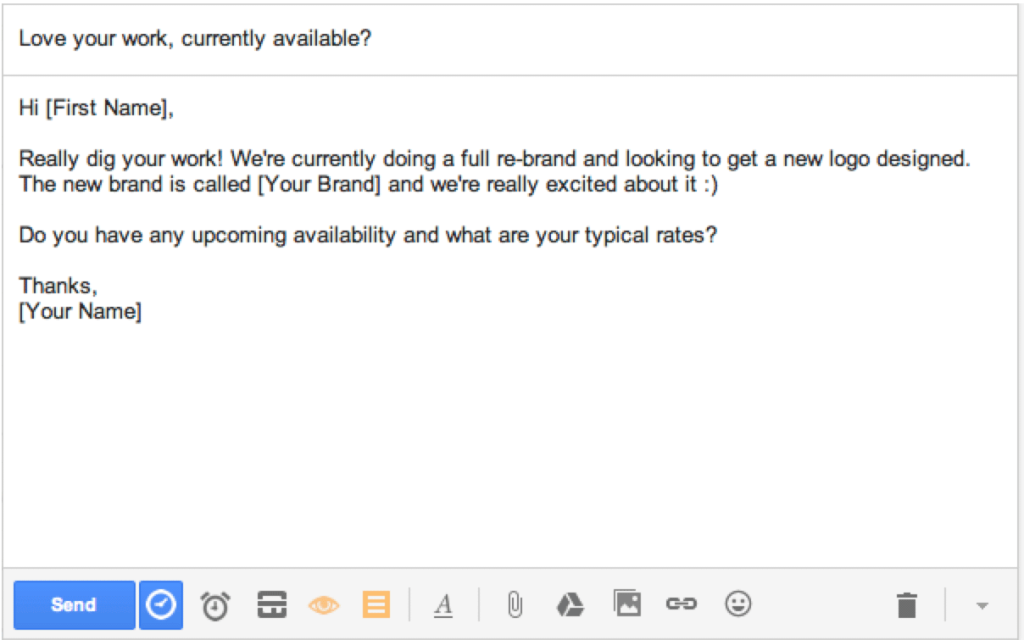 ….This email got about a 90% response rate.
….This email got about a 90% response rate. - Talk to these potential designers and find out if they can work within your budget or have availability. Speaking of budget, that’s something you need to figure out in advance. It’ll be different for everyone, depending on your financial situation, how much you’d actually be willing to spend and how many ‘iterations’ or revisions you expect to get. Generally speaking, anything between $1k-$4k USD is a reasonable expectation for someone who’s really good. (This will also depend on whether they’re just designing a logo for you or an entire ‘branding package’). It’s a good idea to get at least 2 iteration concepts done in case the logo designer is way off the mark on the first attempt.
This is how we met Paul Von Excite. We had contacted a bunch of different logo designers on Dribbble that we really liked, but when we saw Paul’s work it really stood out for us…and after chatting with him, he was an obvious choice. His style fit the visual picture we had in our minds and he fell in love with our story. Picking someone can be pretty tough, there’s so many great designers.
What makes this part so hard – as in all matters relating to this type of design – is how subjective it can be. Make sure you have someone on your team who is in charge of this process and who will be hiring the designer working directly with the him/her. There’s nothing worse than design by committee, especially when it comes to logo design.
It’s also important that you hire someone that will work with you on the logo and not just work on the logo (…Unless you hired the late Paul Rand). From our experience though, a good logo designer will often start by asking you a lot of questions and listening to feedback along the way. At this point, they know nothing about you, your brand, the history of your company or most importantly, who your customers are. Make sure the person you hire asks you these kinds of questions and if they don’t, then you need to provide them with this info at the earliest point possible.
Since this is a rebrand, you’ll already have a ton of information about your customer base and you may already have a good idea of what your new product is going to look like. If not, that’s cool too, because there’s two approaches here:
- You can base your logo around existing materials for your product
- You can base the new look of your product (marketing website, etc.) around the new logo.
Both approaches are fine, it just depends what stage you are at and the reasons behind why you are rebranding.
Traditional Logo or Logotype
An important decision you need to make early on is whether or not you will have a traditional logo accompanied by an icon or a “logotype” logo. A logotype is essentially a wordmark logo that usually doesn’t have a icon associated with it. You’ll often see companies who do this using the first letter of their company as an icon. How important is an icon for your product/service/business? The answer will be very different for every company. If your product is an iPhone app, it’s probably pretty important that you have an icon. If you own a barbershop, maybe it’s less important.
We decided to take a sort of hybrid approach. Since about 30% of our userbase is using our Chrome Extension, we knew a good icon was pretty important, but we were also very set on having a “logotype”. Dribbble and MailChimp have taken some interesting approaches here. They have their main logotype and then a secondary icon they use for other certain mediums.
The Brief
Before Paul starting doing any sketches, we made sure he was properly briefed on our brand and the direction were going in. Here is the actual brief we used, feel free to use this as a template for your own logo design.
At this point, make absolutely certain that your logo designer has as much info as they need. Everything will stem from this information so it’s important they understand how to proceed with your vision for the brand in mind. After all, you spent a ton of time learning about the nature of your product, your ‘cornerstone’ words/emotions and a well-thought out new name.
The Delicate Logo Sketch Process
Now that your logo designer has been briefed, he’s going to disappear for a few days and start sketching some concepts. It’s absolutely essential that you keep your expectations in check. Early sketches are just that – early sketches. They will often not resemble the final version at all. This is a chance to work with your logo designer to really establish the feel.
Next, you’ll start to build on variations. If you agreed to multiple iterations, this is a good chance to really explore two very different options. Our two iterations were somewhat similar at first glance, but really quite different if you start to look closely.
Once you’ve decided on a direction, it’s time to start refining. This is a bit of a painstaking process, but good designers will work with you on this process and explain their decisions. Here is a one of the later sketches from our designer, marking in the decisions for every detail.
Finally, once you have your direction figured out (and assuming you have some revisions available) try to see if certain components of the logo can be modified. Sometimes one will jump off the page at you, and you’ll know in your gut you’ve found it.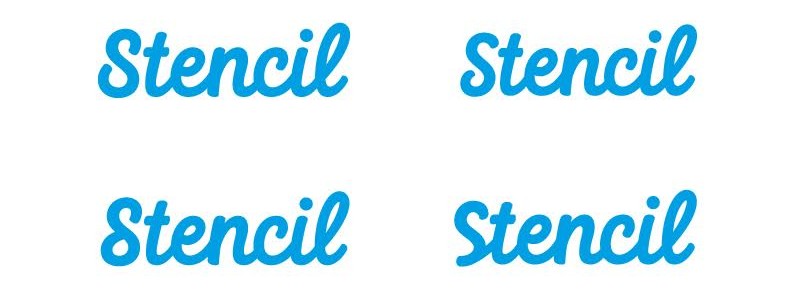 Here is the final version of the logo and we couldn’t be more happy about it:
Here is the final version of the logo and we couldn’t be more happy about it:
Moving Forward
Through this incredible (and humbling) process, we discovered that what we offer isn’t just a way to create images. It’s a starting point for our customers social media, blogging, presentation and email marketing efforts. At it’s core, Stencil is a productivity tool more than anything. We learned how it saves our customers time and lets them create beautiful visuals without having to hire a world-class designer…hey… just like a real-life Stencil! We’re really proud of the new branding and we’re extremely excited to introduce it to the world over the coming months.
We’re going to be launching really soon, be sure to reserve a spot in line and get access to Stencil right when it launches. If you invite 3 friends to sign up, we’ll send you a coupon for 3 months free too!
Would love to hear about your experience rebranding or rebuilding your product. Comment below and tell us what the hardest part was for you!


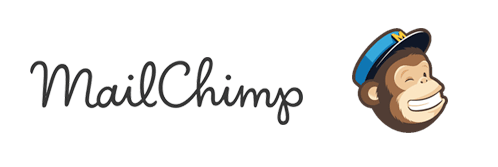

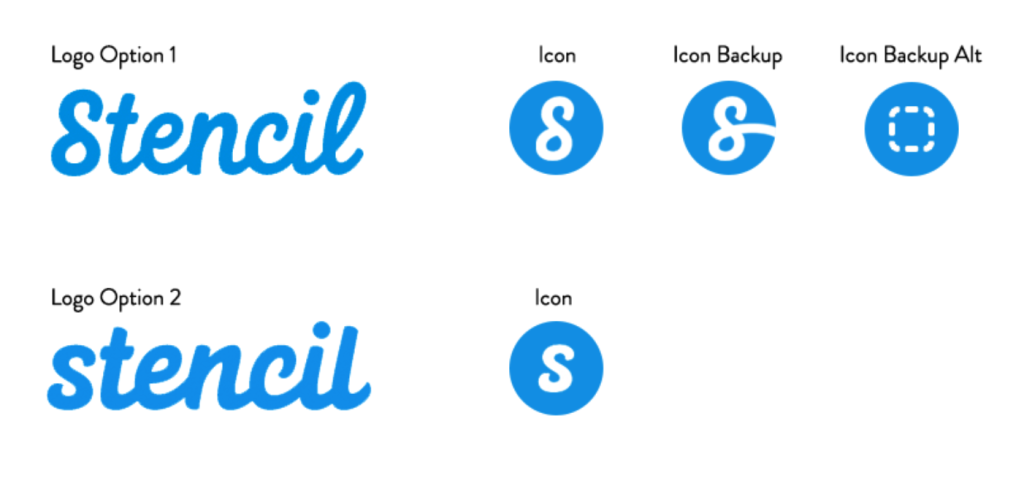
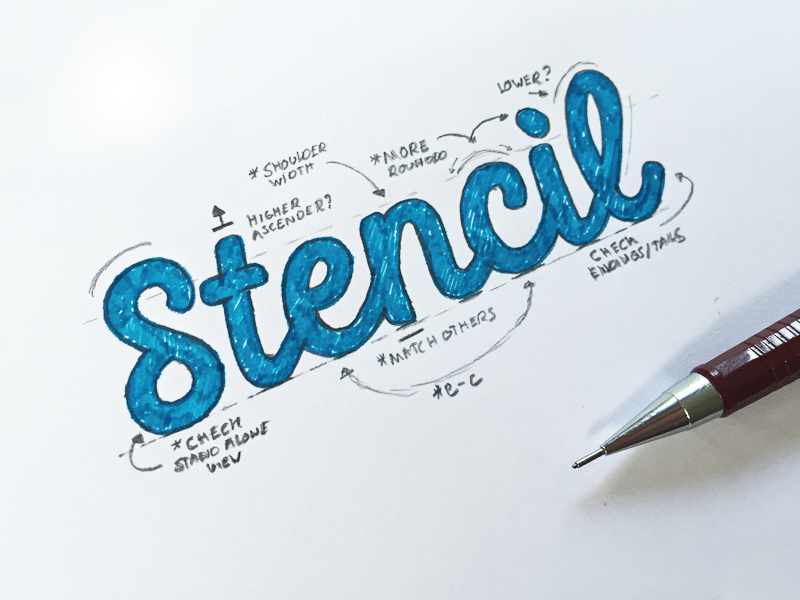



[…] recently rebranded, you might remember us as Share As […]